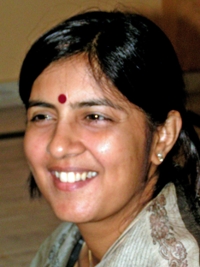The questions outlined above stimulated me to adopt a multi-disciplinary approach that uses historical, ethnographic and sociological methods. Hence, I set out to trace the historical origins of the Anuvrat Movement in India. I relied upon the corpus of Anuvrat literature available in Hindi, some translations available in English, biographies, and the publications of some of the 371 Anuvrat regional centers in India operating under the heading of the Anuvrat Mahasamiti (great organization, or headquarters), such as the fortnightly Anuvrat magazine, annual reports and newsletters. Along with the historical method, I employed the ethnographic research method to understand the attitudes and perspectives of participants in my study, such as the non-Terapanthi Anuvratis,[6] the Terapanthi Anuvratis and the non-Anuvrati Terapanth laity[7] in India and in the diaspora. In order to accomplish my set goals, I conducted 5 interviews among Terapanth monks and nuns and 25 interviews among laity in several Indian small towns and large cities. I took advantage of being an insider to this tradition, and therefore, through a series of associations and contacts, I was able to visit some of the highly active Terapanth centers.
Both my male and female respondents were selected from different social, economic, professional and religious backgrounds. I have used pseudonyms to conceal the identity of my subjects (interviewees). However, I have revealed the identity of scholars and experts in Jainism from my interviews.
Besides these two methodologies, I also conducted a sociological survey. The survey was used to collect data on demographic characteristics, attitudes and behavior of Anuvratis and non-Anuvratis as a measurement to determine the effectiveness of the movement. It took me three months to collect the data, starting from May 2012 through July 2012. More than 200 Indians filled out the survey questionnaire[8] consisting of 30 multiple-choice questions.
Continuing with my fieldwork among the Jain diaspora, I primarily focused on the ethnographic method and conducted nine interviews - six in Miami and three in Los Angeles. The interviewees were laity, professors and scholars of Jainism. Besides these interviews in Miami, I attended monthly Jain study meetings, temple ceremonies, some discourses by the Samanis (liberal-ascetic) and lectures by Jain scholars from India.
 Shivani Bothra
Shivani Bothra
